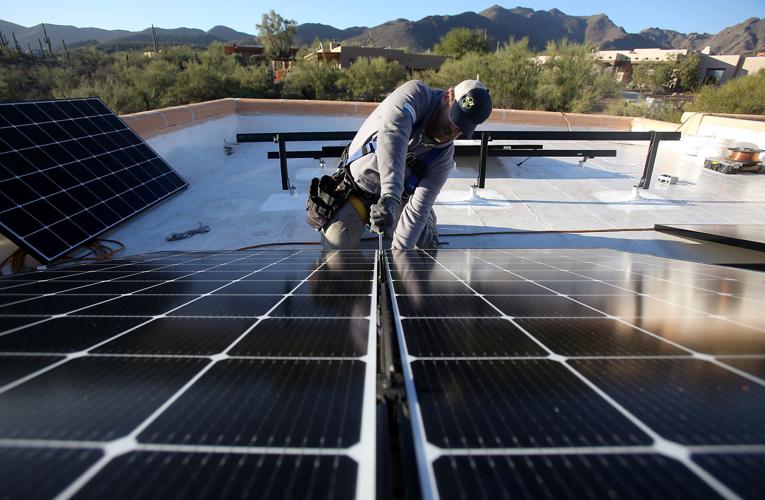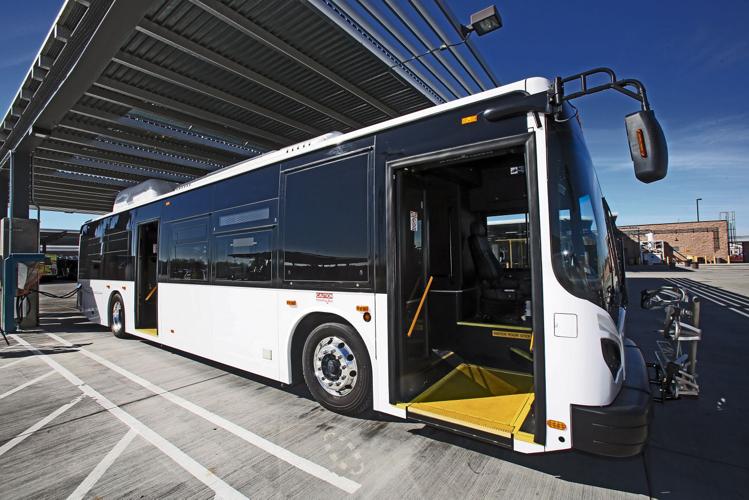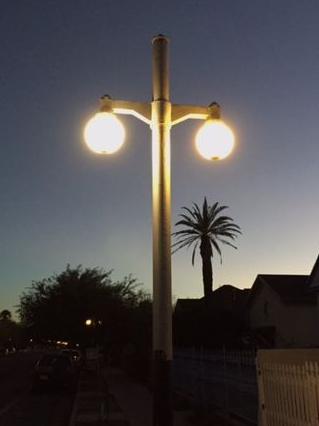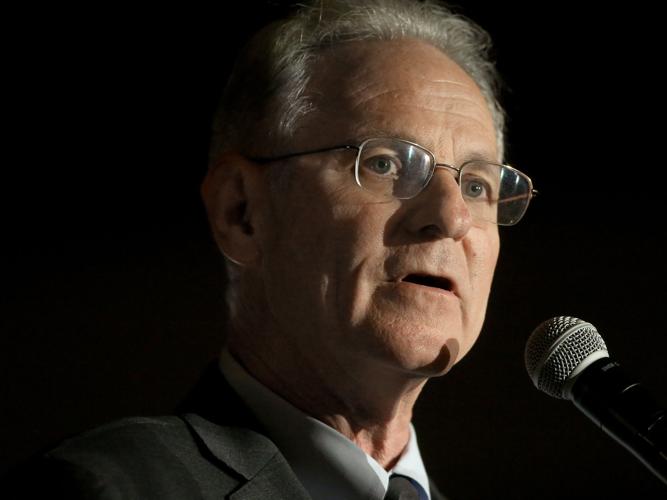Permit-fee breaks for better insulation in new homes.
One hundred percent solar-powered drinking water.
A new “eco-project” in the fashion of the pioneering southeast-side Civano development.
Long-term loans to help city and county governments and the University of Arizona go green.
And, in the future, more public investment in the bus system and other alternative forms of transportation.
These and other ideas are on the minds of Tucson Mayor Jonathan Rothschild and other city officials. They’re contemplating action on climate change in light of President Trump’s recent decision to exit the Paris Climate Accord of 2015.
On Tuesday, the Tucson City Council will take up this potentially touchy issue in a study session aimed at generating ideas and discussion on what to do next.
Some ideas could cost the city money, but others could be done with little to no upfront cost, the mayor said.
Outside the council meeting, potentially record-setting heat will serve as a backdrop, with temperatures forecast to reach 115 degrees Tuesday and Wednesday. While these temperatures aren’t specifically linked to climate change, numerous studies have shown that the Southwest’s temperatures have risen significantly over the past few decades, at rates faster than temperature increases across the entire United States.
The council discussion will come a little more than two weeks after Trump announced the United States would withdraw from the Paris accord. Most nations around the world signed it in December 2015 to set a goal of holding down future global temperature increases to 1.5 degrees Celsius, or 2.7 degrees Fahrenheit.
The president called the agreement a bad deal for this country, one that would impose unfair environmental standards on U.S. companies and workers. He also called it an attack on American sovereignty.
The U.S. had agreed under former President Barack Obama to reduce its greenhouse gas emissions by 26 percent to 28 percent of 2005 levels by 2025 — about 1.6 billion tons, according to The Associated Press.
“This act of withdrawing from the world agreement has spurred all of us on the local level who care about the Earth, biodiversity and quality of life to take another look at what we can do locally,” said Rothschild, one of more than 300 U.S. mayors to sign a letter pledging to uphold the Paris accord’s goals.
“I don’t think anyone in Tucson wants to see summers get hotter,” said the mayor. “We’re focusing on taking a more aggressive approach.”
Trump can do what he wants, but that doesn’t prevent Tucson from acting locally, added Councilman Steve Kozachik, who called for Tuesday’s study session.
“The global issue, as we know, has very local impacts. We want to empower people so they can step up and fill the void.”
urgency is needed
On its face, the tasks ahead to reach the Paris accord’s goals seem staggering.
Diana Liverman, former co-director of the University of Arizona’s Institute for the Environment, said she’s working on a special report for the Intergovernmental Panel on Climate Change on how to hold temperature increases to the 2.7 degree Fahrenheit goal.
From her work so far, “it’s already clear that to get to it requires not only steep emission reductions but actually removing greenhouse gases” from the atmosphere, said Liverman, now a professor of geography and development.
For the United States to do its fair share of the task to hold temperature increases just to 2 degrees C, or 3.6 degrees F, will require this country to reduce its total greenhouse gas emissions by 70 percent by 2020 from 2000 levels. It will also require getting to zero emissions by 2030 with some carbon dioxide actually being removed from the atmosphere by then, Liverman said.
With Arizona generating about 1.5 percent of the annual U.S. total of CO2 emissions, it would need to cut its current emissions total of 105 million metric tons by 73 percent by 2020. Pima County’s current emission level of 14 million metric tons would have to be cut to about 4.2 million by then, Liverman said.
“In Pima County we need to get transportation emissions down and get our electricity out of fossil fuels,” she said.
Anything short of “transformative change” is insufficient to address the challenge of meeting global climate goals, said Benjamin Champion, director of the UA’s Sustainability Office. That can happen over time, but tackling this problem incrementally is fine “only if we use small-scale change to build support and plan much much larger-scale change,” Champion said.
Such a change will require mobilizing multiple sectors of the community, he said. They include residential and commercial building energy use, industrial energy and materials use, transportation, waste, food systems and materials/product supply chains. A supply chain is a distribution channel of goods and components, starting with their suppliers and extending through manufacturers, distributors, retailers and ultimately to consumers.
In Tucson, “there are grass-roots movements afoot in each of these areas, that all need support and growth,” with help from various networks of people and institutions across the community, Champion said.
Specific proposals
Specifically, Rothschild listed these potential solutions:
- Going into partnership with Tucson Electric Power to lease city land to install a large, utility scale solar energy plant in the Avra Valley to make the city’s Central Arizona Project pumping facilities there 100 percent solar. The city gets most of its drinking water from a series of basins where CAP water is recharged into the aquifer and later pumped out.
- Giving developers and homebuilders breaks on permit or impact fees for building eco-friendlier homes and office and commercial buildings.
Builders who install solar panels on homes already are eligible for incentives. Rothschild said incentives could be added for installation of energy-efficient windows and insulation systems.
Incentives could be given to homeowners who retrofit their houses with solar or energy-efficient equipment when they need city permits to do the work, he said. City support can also be given to organizations such as the Tucson Urban League and Community Home Repair Projects of Arizona, which provide weatherization, among many other home-repair projects, for low-income families, the mayor said.
- Using “performance contracts” to obtain loans to include solar power and other energy-saving devices — first in infrastructure such as new buildings, and eventually across city government. With performance contracts, the city arranges for an investor or bank to finance projects, with the city repaying the loan over time using proceeds from savings from reduced energy use.
Similar contracts could be arranged for infrastructure in Pima County, probably the university and potentially Davis-Monthan Air Force Base, Rothschild said.
This idea has already been used to borrow $15 million to install LED lighting in city streetlights and parking garages. So far, 19,487 such lights have been installed — 92 percent of the total planned — and they’ll use 70 percent less electricity than conventional lighting, said Jason Laros, the city’s energy and waste diversion programs manager.
- Encouraging formation of what’s known as 2030 districts, in which building owners and other property owners within specified geographic boundaries commit to reducing their energy and water use 50 percent by 2030. Such a district was recently created for the downtown area. The city could let the district use a city logo on its materials and list the city as a partner, the mayor said.
- Creating another of what Rothschild called an “eco-district,” like Civano, which was developed in the 1990s on the southeast side near Irvington and Houghton roads. Again, the city would give developers incentives to encourage greener construction techniques and low-water-use equipment and facilities.
- Saving energy in transportation by more rapidly switching the city’s bus fleets and other vehicle fleets to compressed natural gas and other more energy-efficient fuels. Future spending on alternative transportation methods such as transit could also be on the table. The Pima Association of Governments is starting to plan for the re-authorization of the Regional Transportation Authority half-cent sales tax and “this topic is on the forefront,” Rothschild said.
For now, the mayor isn’t talking about imposing new regulations on businesses or homeowners to force them to use less or greener energy. A 2006 statewide proposition put the damper on many such efforts by requiring local governments to compensate property owners for any land-use changes that reduce property values.
Two years ago, the Arizona Legislature went a step further, enacting a law forbidding local governments from even conducting “climate audits” of privately owned buildings to try to spur reduced energy use, Rothschild said. That law passed after the city of Phoenix sought to conduct such audits.
Kozachik said he doesn’t want to “cram anything down anyone’s throat,” but wants to work with builders and other sectors of the business community to see if there’s more they can do to save energy. Another idea is to dust off a series of voluntary climate-change mitigation measures that the city approved six years ago to see if they can be employed, he said.
Officials from the Tucson Metropolitan Chamber of Commerce and the Southern Arizona Home Builders Association said they can’t comment on possible climate-change mitigation strategies at this point.
SAHBA President David Godlewski noted that upgrades to the city’s building codes in the past decade have made the codes 30 percent more energy efficient than they were in 2006. Chamber CEO Mike Varney said the chamber’s board hasn’t discussed this subject.
Already, “there are many builders who exceed energy-efficiency requirements,” Godlewski said. “Insulation is better. Windows are more energy-efficient. We’ve adjusted the sizing of heating and cooling equipment to be better equipped, based on what the consumer is asking for.
“We’ve seen consumers by choice buying more and wanting more energy-efficient homes. Builders are building them,” he said.
UA sustainability official Champion praised Rothschild’s strategies for reducing city energy use. But “transportation is absolutely key” for reducing greenhouse gas emissions, he added.
A recent Pima Association of Governments report said transportation accounts for 30 percent of emissions in eastern Pima County. Nationally, experts say transportation recently surpassed buildings as the biggest source of greenhouse gas emissions in the United States.
While light rail is “sexy and cool, finding a way to fund the city’s bicycle master plan and a much more comprehensive and reliable bus system throughout the region would come first in my opinion,” and should be more cost-effective, Champion said.
“But that’s how transformative change works. You do the bicycle and bus network upgrades, and all the while start planning the bigger-ticket items that happen in a decade or two,” he said.









